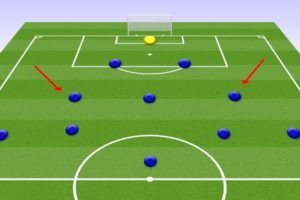6 v 6 Soccer Formations: A Comprehensive Guide for Optimal Team Performance
6 v 6 soccer is a game format that is still popular in many leagues and tournaments, particularly indoors. As such, it is important for coaches and players to understand the best formations to use in order to maximize their chances of winning. The right formation can make all the difference in a game, allowing a team to play to its strengths and exploit its opponents’ weaknesses.
There are several different formations that can be used in 6 v 6 soccer, each with its own advantages and disadvantages. For example, the 2-2-1 formation is arguably the most common, as it offers a good balance between defense and attack. This formation features two defenders, two midfielders, and one forward, and is well-suited to teams that like to build attacks from the back while still maintaining a solid defensive structure.
Other popular 6 v 6 soccer formations include the 2-1-2, which enables the use of triangles all over the pitch, and the 2-3 formation, which is ideal for teams that like to dominate possession and play with a high tempo. Ultimately, the best formation for a particular team will depend on a range of factors, including the players’ individual strengths and weaknesses, the opponents they are facing, and the overall game plan of the team.
Importance of 6 v 6 Soccer Formations
6 v 6 soccer formations are an essential aspect of the game. A team’s formation can affect the outcome of a match, and it is crucial to choose a formation that suits the team’s strengths and weaknesses. This section will discuss the advantages and disadvantages of 6 v 6 soccer formations.
Advantages of 6 v 6 Soccer Formations
One of the main advantages of 6 v 6 soccer formations is that they allow teams to maintain a balance between defense and attack. With only six players on each team, it is easier to maintain a cohesive unit and ensure that all players are involved in both defending and attacking.
Another advantage of 6 v 6 soccer formations is that they are flexible and can be adapted to suit different playing styles. For example, teams can choose to play with a more defensive or attacking formation, depending on their opponents’ strengths and weaknesses.
Furthermore, 6 v 6 soccer formations can help teams to develop their players’ skills. By playing in different positions within the formation, players can improve their overall understanding of the game and develop a range of skills.
Disadvantages of 6 v 6 Soccer Formations
One of the main disadvantages of 6 v 6 soccer formations is that they can be physically demanding for players. With only six players on each team, players are required to cover more ground and may become fatigued more quickly.
Another disadvantage of 6 v 6 soccer formations is that they can be vulnerable to counter-attacks. With fewer players in defense, teams may struggle to defend against quick counter-attacks from their opponents.
Finally, 6 v 6 soccer formations can be challenging to master, and it may take time for teams to find a formation that suits their playing style and strengths. Teams must experiment with different formations and be willing to make adjustments as necessary.
| Advantages | Disadvantages |
|---|---|
| Allows for a balance between defense and attack | Can be physically demanding for players |
| Flexible and can be adapted to suit different playing styles | Vulnerable to counter-attacks |
| Helps to develop players’ skills | Challenging to master |
Popular 6 v 6 Soccer Formations
3-1-1 Formation

The 3-1-1 formation is a popular formation in 6 v 6 soccer. It consists of three defenders, one midfielder, and one attacker. This formation is often used when a team wants to focus on defense and counter-attacking. The three defenders provide a solid defensive base, while the midfielder and attacker work together to create scoring opportunities.
One of the advantages of the 3-1-1 formation is that it allows the team to quickly transition from defense to offense. The three defenders can quickly win the ball back and pass it to the midfielder or attacker, who can then launch a counter-attack. However, this formation can also be vulnerable to teams that play with a lot of width, as it can be difficult for the defenders to cover the entire field.
2-2-1 Formation

The 2-2-1 formation is another popular formation in 6 v 6 soccer. It consists of two defenders, two midfielders, and one attacker. This formation is often used when a team wants to maintain a balance between defense and offense. The two defenders provide a solid defensive base, while the two midfielders and attacker work together to create scoring opportunities.
One of the advantages of the 2-2-1 formation is that it allows the team to maintain possession of the ball and build attacks from the back. The two midfielders can drop deep to receive the ball from the defenders, and then use their passing skills to create scoring opportunities for the attacker. However, this formation can also be vulnerable to teams that play with a lot of physicality, as the midfielders may struggle to hold onto the ball under pressure.
2-1-2 Formation

The 2-1-2 formation is a slightly more attacking formation in 6 v 6 soccer. It consists of two defenders, one midfielder, and two attackers. This formation is often used when a team wants to focus on attacking and scoring goals. The two attackers work together to create scoring opportunities, while the defender and midfielder provide a solid defensive base.
One of the advantages of the 2-1-2 formation is that it allows the team to put more pressure on the opposition’s defense. The two attackers can work together to create scoring opportunities, while the defender and midfielder can provide cover in case of a counter-attack. However, this formation can also be vulnerable to teams that play with a lot of width, as the defenders may struggle to cover the entire field.
Factors to Consider When Choosing a 6 v 6 Soccer Formation
Player Positions
One of the most important factors to consider when choosing a 6 v 6 soccer formation is the positioning of your players. In a 6 v 6 game, the field is smaller, and each player has more ground to cover. Therefore, it is crucial to have players who are versatile and can play multiple positions.
Here are some common player positions in a 6 v 6 soccer game:
| Position | Description |
|---|---|
| Goalkeeper | The player who defends the goal and prevents the opposing team from scoring. |
| Defenders | The players who defend the goal and prevent the opposing team from scoring. |
| Midfielders | The players who link the defense and the offense and help control the pace of the game. |
| Forwards | The players who attack the opposing team’s goal and try to score. |
Team Strategy
Another important factor to consider when choosing a 6 v 6 soccer formation is your team’s strategy. Do you want to play an aggressive, attacking style of soccer, or do you want to focus on defense and counterattacks?
Here are some common team strategies in a 6 v 6 soccer game:
- High Pressure: This strategy involves pressuring the opposing team high up the field to force turnovers and create scoring opportunities.
- Counterattack: This strategy involves defending deep and quickly transitioning to offense when the opportunity arises.
- Possession: This strategy involves keeping the ball for long periods of time and waiting for the right moment to attack.
Opponent Analysis
Finally, it is essential to analyze your opponent when choosing a 6 v 6 soccer formation. What are their strengths and weaknesses? Do they have any star players who need to be marked closely?
Here are some common opponent analysis factors in a 6 v 6 soccer game:
- Formation: What formation does the opposing team typically play, and how can you exploit their weaknesses?
- Player Roles: Who are their key players, and how can you neutralize them?
- Style of Play: What is the opposing team’s style of play, and how can you counter it?
Tips for Effective 6 v 6 Soccer Formations
When it comes to 6 v 6 soccer, having the right formation can make all the difference in winning or losing a game. Here are some tips to help create an effective 6 v 6 soccer formation:
Communication
Communication is key in any team sport, and soccer is no exception. It is important to establish clear lines of communication between players on the field. This includes calling out positions, alerting teammates of incoming opponents, and coordinating offensive and defensive strategies. Encouraging players to communicate effectively can lead to a more cohesive and successful team.
Flexibility
While having a set formation is important, it is also important to be flexible and adaptable during a game. Coaches should encourage players to be comfortable playing in multiple positions and to be able to adjust the formation as needed. This can help the team respond to unexpected changes in the game and keep the opposition on their toes.
Practice
Practice is essential to developing an effective 6 v 6 soccer formation. Coaches should work with their teams to develop strategies and practice them regularly. This can include practicing set pieces, such as corner kicks and free kicks, as well as working on defensive and offensive plays. Consistent and focused practice can help players feel more confident and comfortable with the formation, leading to better performance during games.






